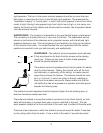
Commercially built diffusers are available but large bookcases and irregularly shaped
furniture will also serve the same purpose. They reflect sounds in a highly randomized
way which effectively “scatters” the sound in all directions. Place the diffuser where you
would otherwise place the absorptive material (using the “mirror trick”), to break up the
first early reflections and scatter them randomly throughout the room.
Commercially available fiberglass, foam and diffusion panels may not be aesthetically
acceptable in many installations, particularly when the home theatre room serves multi-
ple purposes. All of these materials can be covered with acoustically-transparent cloth
for design considerations. It is important that the cloth be acoustically transparent,
however, or else the effectiveness of the absorptive material will be greatly reduced.
The simplest test for this is to hold a large sample of the cloth in front of a speaker
playing the pink noise found in Chapter 6 of the
WOW! laserdisc. If you can move the
cloth in front of the speaker without hearing a difference, you are all set.
Large expanses of glass can be challenging. They reflect mids and highs but often
pass bass through almost as though they didn’t exist. The result is a characteristically
bright, rough sound which can be difficult to correct electronically. The best treatment
is generally the heaviest insulated drapes which can be found. (Incidentally, these
serve double duty, controlling light which might otherwise fall on the screen.)
The materials just discussed are ineffective at lower frequencies. See the discussion
on Standing Waves for more information about treating environments with low frequen-
cy response problems.
EXCESSIVE USE OF ABSORPTIVE MATERIALS
People are sometimes
tempted to go over-
board with absorptive
material once they dis-
cover how powerful its
use can be. While the
ideal home theatre
should be considerably
“deader” acoustically
than a typical living
room, it still needs some
reflectivity and diffusion.
10
Surround speaker
Screen speaker
Absorptive "dead" zoneReflective "live" zone
ROOM ABSORPTION FOR HOME THEATRE SYSTEMS
• "Dead" zone absorbs
front speaker reflection.
• "Live" zone provides
surround propagation


















